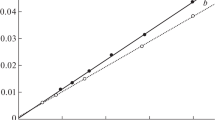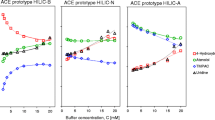Summary
Uncharged solutes devoid of inherent detectable properties can be monitored and quantified in reversed-phase chromatographic systems by including a non-ionic detectable component (probe) in the eluent. Response models have been developed, which are based on the fact that the distribution of the solute and the probe are connected to each other by common interaction effects, such as competition for the binding surface.
The direction and magnitude of the indirect response can be predicted quantitatively by means of expressions which clearly show the influence of the retention of the solute relative to the probe as well as the effect of the solid phase coverage by the probe.
The relatively low response obtained in non-ionic systems may be due to a low loading of the probe on the solid phase and to a simultaneous distribution of the solute in complexed and uncomplexed forms, the two distribution modes giving opposite response patterns.
Similar content being viewed by others
References
J. Crommen, G. Schill, D. Westerlund, L. Hackzell, Chromatographia24, 252 (1987).
M. Denkert, L. Hackzell, G. Schill, E. Sjögren, J. Chromatogr.,218, 31 (1981).
L. Hackzell, G. Schill, Chromatographia,15, 437 (1982).
L. Hackzell, T. Rydberg, G. Schill, J. Chromatogr.,282, 179 (1983).
J. Crommen, J. Pharm. Biomed. Anal.,1, 549 (1983).
J. Crommen, P. Herne, J. Pharm. Biomed. Anal.,2, 241 (1984).
T. Gnanasambandan, H. Freiser, Anal. Chem.54, 1282 (1982).
H. Small, T. E. Miller, Jr, Anal. Chem.,54, 462 (1982).
P. Herné, M. Renson, J. Crommen, Chromatographia,19, 274 (1984).
J. E. Parkin, J. Chromatogr.,287, 457 (1984).
G. Vigh, A. Leitold, J. Chromatogr.,312 345 (1984).
T. Takeuchi, E. S. Yeung, J. Chromatogr.,366, 145 (1986).
J. Ye, R. P. Baldwin, K. Ravichandran, Anal. Chem.,58, 2337 (1986).
G. Schill, J. Crommen, TrAC,6, 111 (1987).
F. Helffereich, G. Klein, Multicomponent Chromatography, Marcel Dekker, New York, 1970.
F. Riedo, E. Kovats, J. Chromatogr.,239, 1 (1982).
H. Poppe, University of Amsterdam, 1984.
R. M. McCormick, B. L. Karger, Anal. Chem.,52, 2249 (1980).
J. H. Knox, R. Kaliszan, J. Chromatogr.,349, 211 (1985).
E. Arvidsson, J. Crommen, G. Schill, D. Westerlund, Chromatographia,24, 460 (1987).
Author information
Authors and Affiliations
Rights and permissions
About this article
Cite this article
Crommen, J., Schill, G. & Herné, P. Indirect detection in liquid chromatography. II. Response models for reversed-phase non-ionic systems. Chromatographia 25, 397–403 (1988). https://doi.org/10.1007/BF02324781
Received:
Accepted:
Issue Date:
DOI: https://doi.org/10.1007/BF02324781




